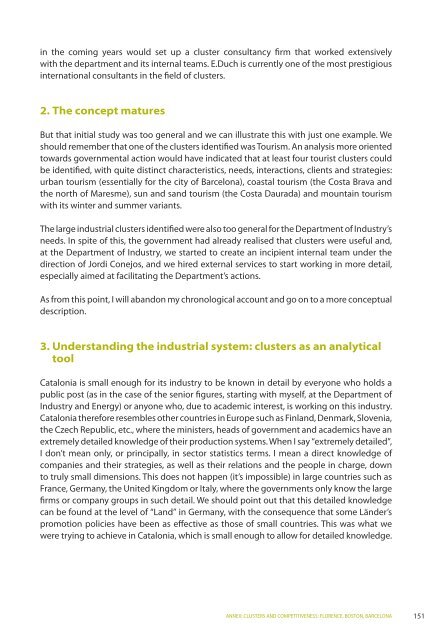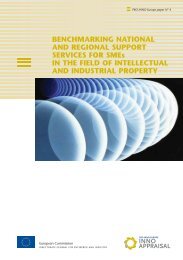Clusters and competitiveness - PRO INNO Europe
Clusters and competitiveness - PRO INNO Europe
Clusters and competitiveness - PRO INNO Europe
You also want an ePaper? Increase the reach of your titles
YUMPU automatically turns print PDFs into web optimized ePapers that Google loves.
in the coming years would set up a cluster consultancy firm that worked extensively<br />
with the department <strong>and</strong> its internal teams. E.Duch is currently one of the most prestigious<br />
international consultants in the field of clusters.<br />
2. The concept matures<br />
But that initial study was too general <strong>and</strong> we can illustrate this with just one example. We<br />
should remember that one of the clusters identified was Tourism. An analysis more oriented<br />
towards governmental action would have indicated that at least four tourist clusters could<br />
be identified, with quite distinct characteristics, needs, interactions, clients <strong>and</strong> strategies:<br />
urban tourism (essentially for the city of Barcelona), coastal tourism (the Costa Brava <strong>and</strong><br />
the north of Maresme), sun <strong>and</strong> s<strong>and</strong> tourism (the Costa Daurada) <strong>and</strong> mountain tourism<br />
with its winter <strong>and</strong> summer variants.<br />
The large industrial clusters identified were also too general for the Department of Industry’s<br />
needs. In spite of this, the government had already realised that clusters were useful <strong>and</strong>,<br />
at the Department of Industry, we started to create an incipient internal team under the<br />
direction of Jordi Conejos, <strong>and</strong> we hired external services to start working in more detail,<br />
especially aimed at facilitating the Department’s actions.<br />
As from this point, I will ab<strong>and</strong>on my chronological account <strong>and</strong> go on to a more conceptual<br />
description.<br />
3. Underst<strong>and</strong>ing the industrial system: clusters as an analytical<br />
tool<br />
Catalonia is small enough for its industry to be known in detail by everyone who holds a<br />
public post (as in the case of the senior figures, starting with myself, at the Department of<br />
Industry <strong>and</strong> Energy) or anyone who, due to academic interest, is working on this industry.<br />
Catalonia therefore resembles other countries in <strong>Europe</strong> such as Finl<strong>and</strong>, Denmark, Slovenia,<br />
the Czech Republic, etc., where the ministers, heads of government <strong>and</strong> academics have an<br />
extremely detailed knowledge of their production systems. When I say “extremely detailed”,<br />
I don’t mean only, or principally, in sector statistics terms. I mean a direct knowledge of<br />
companies <strong>and</strong> their strategies, as well as their relations <strong>and</strong> the people in charge, down<br />
to truly small dimensions. This does not happen (it’s impossible) in large countries such as<br />
France, Germany, the United Kingdom or Italy, where the governments only know the large<br />
firms or company groups in such detail. We should point out that this detailed knowledge<br />
can be found at the level of “L<strong>and</strong>” in Germany, with the consequence that some Länder’s<br />
promotion policies have been as effective as those of small countries. This was what we<br />
were trying to achieve in Catalonia, which is small enough to allow for detailed knowledge.<br />
ANNEX: CLUSTERS AND COMPETITIVENESS: FLORENCE, BOSTON, BARCELONA<br />
151
















